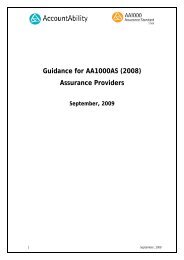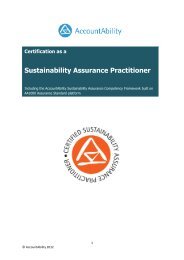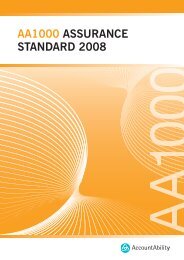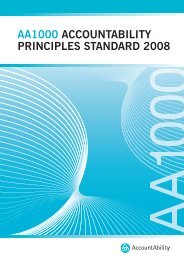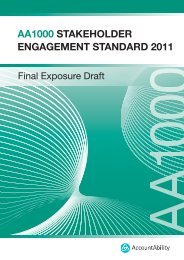The Stakeholder Engagement Manual Volume 2 - AccountAbility
The Stakeholder Engagement Manual Volume 2 - AccountAbility
The Stakeholder Engagement Manual Volume 2 - AccountAbility
You also want an ePaper? Increase the reach of your titles
YUMPU automatically turns print PDFs into web optimized ePapers that Google loves.
Introduction<br />
WHAT IS IN THIS HANDBOOK?<br />
THIS HANDBOOK PRESENTS STAKEHOLDER ENGAGEMENT<br />
IN FIVE STAGES:<br />
- Th e fi rst Stage is an overall consideration of strategic business objectives, how<br />
these relate to stakeholders and specifi c issues, and how you can undertake an<br />
initial prioritisation of stakeholders and issues for further analysis.<br />
- Th e second Stage introduces diff erent levels of engagement, and guides you<br />
in analysing your existing relationships, available resources and organisational<br />
constraints. It also helps you to learn more about specifi c stakeholder’s<br />
representatives, and to decide on what kind of relationship you want to develop<br />
with these stakeholders.<br />
- Th e third Stage addresses questions of internal and external competencies and<br />
capacities to engage, and provides guidance on how you can ensure that all parties<br />
to an engagement are able to join and take part in it eff ectively.<br />
- Th e fourth Stage outlines diff erent engagement techniques, and – building<br />
on the previous steps – helps you to design an approach that suits the needs of<br />
your specifi c situation and helps you to reach your objectives.<br />
- Finally, in the fi fth Stage, this handbook will provide you with guidance on how<br />
to follow up on the outputs of engagement, and how to ensure that your<br />
stakeholders feel assured regarding the quality of your eff orts.<br />
For the sake of clarity and ease of use, the handbook presents stakeholder<br />
engagement as a process consisting of discrete stages. <strong>The</strong> stages represent groups<br />
of necessary questions and processes in planning and managing stakeholder<br />
engagement, but will not always be best covered in such a strict sequence. It may well<br />
be necessary to carry out several of the described activities at the same time, or to<br />
return to ‘previous’ steps in order to clarify or reconsider.<br />
Th e process for stakeholder engagement presented here is underpinned by the<br />
principles of materiality, completeness and responsiveness. Th e relevance of these<br />
principles in the individual stages is described in each chapter. Th ey are further<br />
outlined later in this introduction, on p15.<br />
Th e handbook includes a number of tables, tools and templates which users can<br />
apply to their own context.<br />
Th ese can be downloaded from www.accountability.org.uk.<br />
Each chapter consists of:<br />
- Purpose: An outline of the objectives and rationale for undertaking this Stage.<br />
- Principles: An explanation of how this Stage relates to the principles of<br />
materiality, completeness and responsiveness.<br />
- Process: Practical guidance for each of the key processes, decisions and actions<br />
involved at this Stage.<br />
- Practical examples: Organisational policies and experiences and fi rst hand<br />
comments from practitioners.



